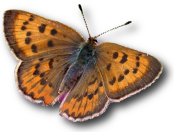 Art Shapiro's Butterfly Site
Art Shapiro's Butterfly Site
Monitoring butterfly populations across Central California for more than 35 years… Welcome to Art's Butterfly World
This website describes over 34 years of data collected by Dr. Arthur Shapiro, professor of Evolution and Ecology at the University of California, Davis, in his continuing effort to regularly monitor butterfly population trends on a transect across central California. Ranging from the Sacramento River delta, through the Sacramento Valley and Sierra Nevada mountains, to the high desert of the western Great Basin, fixed routes at ten sites have been surveyed at approximately two-week intervals since as early as 1972. The sites represent the great biological, geological, and climatological diversity of central California.
As of the end of 2006, Dr. Shapiro has logged 5476 site-visits and tallied approximately 83,000 individual records of 159 butterfly species and subspecies. This major effort is continuing and represents the world’s largest dataset of intensive site-specific data on butterfly populations collected by one person under a strict protocol. We have also collated monthly climate records for the entire study period from weather stations along the transect.
We built this website as a portal for Dr. Shapiro’s data and observations, supported by National Science Foundation Biological Databases and Informatics Grant DBI-0317483. Much of the data is freely available (Please Contact Us for more information).
We created three educational modules for high school and college level instructors in lessons about species composition and climate change. They incorporate specific aspects of butterfly natural history, phenology, long-term population dynamics, and statistical analysis, using the data from this site. They also comply with California high school education standards.
Special thanks goes out to the crew who helped Art when they could and contributed material for this website.
Table 1. Characteristics of Butterfly Monitoring Sites, Listed from West to East
| Site Name | Elevation (meters) | Number of Recorded Species and Subspecies | County | Site Characteristics |
|---|---|---|---|---|
| Suisun Marsh | 0-1 | 60 | Solano | Tidally-influenced complex of brackish and freshwater marsh. Plants include: halophytes, sedges, rushes, cattails, reeds, and herbaceous perennial composites. |
| Gates Canyon | 190-600 | 78 | Solano | Inner Coast Range foothill canyon. Vegetation includes: Interior Live Oak woodland, Blue Oak woodland, Chaparral, Gray Pine, and riparian forest of Cottonwood, Bigleaf Maple, and Alder. |
| West Sacramento | 9 | 58 | Yolo | Central Valley Floor. Dense riparian Cottonwood and Willow forest with Valley Oak and Ash. |
| North Sacramento | 8 | 62 | Sacramento | Central Valley Floor. Valley Oak woodland; riparian Cottonwood and Willow; annual grassland. |
| Rancho Cordova | 18 | 58 | Sacramento | Eastern edge of Central Valley. Interior Live Oak-Gray Pine woodland, Valley Oak-dominated riparian forest, and annual grassland. |
| Washington | 850-1200 | 104 | Nevada | Sierra Foothills. Deep canyon with mixed serpentine and metasedimentary geology. Canyon Live Oak woodland with mesic mixed lower-montane forest including Douglas Fir, Incense Cedar, and Ponderosa Pine. |
| Lang Crossing | 1500-1700 | 116 | Nevada | West-slope Sierra Nevada. Mosaic of xerophytic vegetation (Goldencup Oak and Manzanita) and moist slopes with mixed mesic forest (including Douglas Fir, Ponderosa, and Sugar Pines); site also includes a large wet meadow with boggy areas. |
| Donner Pass | 2000-2200 | 119 | Nevada & Placer | High Sierra. Montane communities with local subalpine elements; granite balds with herbs and low shrubs; mature Red Fir forest; large wet and dry meadow complex with a few boggy spots, fringing Willows and Mountain Alders. |
| Castle Peak | 2400-2775 | 96 | Nevada | High Sierra. Subalpine and alpine vegetation; tree-line of Mountain Hemlock, Lodgepole Pine, Western Whitebark, and White Pine; persistent snow fields, boggy seeps, and wet meadows. |
| Sierra Valley | 1500 | 93 | Sierra | East side of Sierra: Wet and dry meadows with Juniper-shrub steppe and irrigated alfalfa fields. |